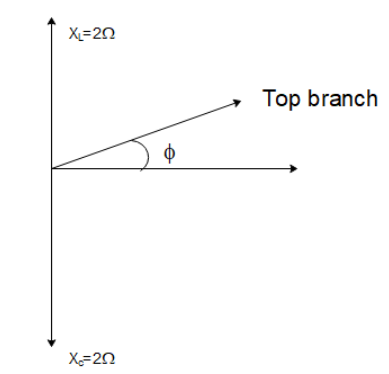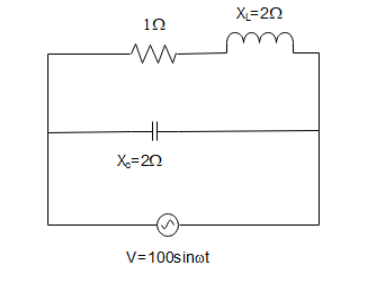Answer
64.8k+ views
Hint: In this solution, we will use the principles of an LCR circuit under an AC power supply. The impudence of an inductor leads to the resistor’s resistance which in turn leads to the impedance of a capacitor.
Formula used: In this solution, we will use the following formula:
- Impedance of a series LCR circuit: \[z = R + j\left( {{X_L} - {X_C}} \right)\] where $R$ is the resistance, ${X_L}$ is the inductive impedance and ${X_C}$ is the capacitive inductance and $j = \sqrt { - 1} $
- Magnitude of Impedance of a series LCR circuit: \[\left| z \right| = \sqrt {{R^2} + {{\left( {X_L^2 - X_C^2} \right)}^2}} \] where $R$ is the resistance, ${X_L}$ is the inductive impedance, and ${X_C}$ is the capacitive inductance.
Complete step by step answer:
In the given, A.C. circuit, we will check all the options one by one.
To calculate the impedance, we will calculate the impedance of the top branch (containing the resistor and the inductor) and that of the bottom branch (containing the capacitor).
The impedance of the top branch will be
${Z_1} = R + j{X_L}$
$ \Rightarrow {Z_1} = 1 + 1j$
where $j = \sqrt { - 1} $. Similarly, the impedance of the bottom branch will be
${Z_2} = 0 - j{X_C}$
$ \Rightarrow {Z_2} = - 2j$
We want to find the impedance of the circuit in option (A). To do so, we first need to find the phase angle of the top branch with the potential provided by the battery. The angle formed by the top branch will be
$\phi = {\tan ^{ - 1}}\left( {\dfrac{{{X_L}}}{R}} \right)$
Which gives us
$\phi = {\tan ^{ - 1}}\left( {\dfrac{1}{1}} \right)$
$ \Rightarrow \phi = 45^\circ $
And its magnitude will be $\left| {{Z_1}} \right| = \sqrt {{R^2} + X_L^2} $
$ \Rightarrow \left| {{Z_1}} \right| = \sqrt {{1^2} + {1^2}} $
Which gives us
$\left| {{Z_1}} \right| = \sqrt 2 $

So, the top branch will be leading in phase by $45^\circ $ with the battery potential. The bottom branch only has a capacitor so it will be lagging in phase from the potential by $90^\circ $. So, the net angle between the top branch and the bottom branch will be $90 + 45 = 135^\circ $. So, the net impedance can then be calculated as
\[Z = \sqrt {Z_1^2 + Z_2^2 + 2{Z_1}{Z_2}\cos 135^\circ } \]
\[Z = \sqrt {{{\sqrt 2 }^2} + {2^2} + 2\sqrt 2 (2)\left( {\dfrac{{ - 1}}{{\sqrt 2 }}} \right)} \]
The net magnitude of the impedance of the circuit will be
\[Z = \sqrt {2 + 4 - 4} \]
\[ \Rightarrow Z = \sqrt 2 \]
Hence option (A) is incorrect.
Note: The power factor is the cosine of the angle formed by the current in the circuit with the net impedance. So,
$\cos \theta = \dfrac{R}{Z} = \dfrac{1}{{\sqrt 2 }}$ which is the power factor.
To calculate the average power supplied and the peak current, we have to use the principles of RMS current.
So, ${i_{RMS}} = {V_{RMS}}/{Z_1}$
$ \Rightarrow {i_{RMS}} = \dfrac{{100/\sqrt 2 }}{{\sqrt 2 }} = 50\,A$
Hence the peak current will be
${i_{peak}} = \sqrt 2 {i_{RMS}} = 50\sqrt 2 A$
Formula used: In this solution, we will use the following formula:
- Impedance of a series LCR circuit: \[z = R + j\left( {{X_L} - {X_C}} \right)\] where $R$ is the resistance, ${X_L}$ is the inductive impedance and ${X_C}$ is the capacitive inductance and $j = \sqrt { - 1} $
- Magnitude of Impedance of a series LCR circuit: \[\left| z \right| = \sqrt {{R^2} + {{\left( {X_L^2 - X_C^2} \right)}^2}} \] where $R$ is the resistance, ${X_L}$ is the inductive impedance, and ${X_C}$ is the capacitive inductance.
Complete step by step answer:
In the given, A.C. circuit, we will check all the options one by one.
To calculate the impedance, we will calculate the impedance of the top branch (containing the resistor and the inductor) and that of the bottom branch (containing the capacitor).
The impedance of the top branch will be
${Z_1} = R + j{X_L}$
$ \Rightarrow {Z_1} = 1 + 1j$
where $j = \sqrt { - 1} $. Similarly, the impedance of the bottom branch will be
${Z_2} = 0 - j{X_C}$
$ \Rightarrow {Z_2} = - 2j$
We want to find the impedance of the circuit in option (A). To do so, we first need to find the phase angle of the top branch with the potential provided by the battery. The angle formed by the top branch will be
$\phi = {\tan ^{ - 1}}\left( {\dfrac{{{X_L}}}{R}} \right)$
Which gives us
$\phi = {\tan ^{ - 1}}\left( {\dfrac{1}{1}} \right)$
$ \Rightarrow \phi = 45^\circ $
And its magnitude will be $\left| {{Z_1}} \right| = \sqrt {{R^2} + X_L^2} $
$ \Rightarrow \left| {{Z_1}} \right| = \sqrt {{1^2} + {1^2}} $
Which gives us
$\left| {{Z_1}} \right| = \sqrt 2 $

So, the top branch will be leading in phase by $45^\circ $ with the battery potential. The bottom branch only has a capacitor so it will be lagging in phase from the potential by $90^\circ $. So, the net angle between the top branch and the bottom branch will be $90 + 45 = 135^\circ $. So, the net impedance can then be calculated as
\[Z = \sqrt {Z_1^2 + Z_2^2 + 2{Z_1}{Z_2}\cos 135^\circ } \]
\[Z = \sqrt {{{\sqrt 2 }^2} + {2^2} + 2\sqrt 2 (2)\left( {\dfrac{{ - 1}}{{\sqrt 2 }}} \right)} \]
The net magnitude of the impedance of the circuit will be
\[Z = \sqrt {2 + 4 - 4} \]
\[ \Rightarrow Z = \sqrt 2 \]
Hence option (A) is incorrect.
Note: The power factor is the cosine of the angle formed by the current in the circuit with the net impedance. So,
$\cos \theta = \dfrac{R}{Z} = \dfrac{1}{{\sqrt 2 }}$ which is the power factor.
To calculate the average power supplied and the peak current, we have to use the principles of RMS current.
So, ${i_{RMS}} = {V_{RMS}}/{Z_1}$
$ \Rightarrow {i_{RMS}} = \dfrac{{100/\sqrt 2 }}{{\sqrt 2 }} = 50\,A$
Hence the peak current will be
${i_{peak}} = \sqrt 2 {i_{RMS}} = 50\sqrt 2 A$
Recently Updated Pages
Write a composition in approximately 450 500 words class 10 english JEE_Main

Arrange the sentences P Q R between S1 and S5 such class 10 english JEE_Main

What is the common property of the oxides CONO and class 10 chemistry JEE_Main

What happens when dilute hydrochloric acid is added class 10 chemistry JEE_Main

If four points A63B 35C4 2 and Dx3x are given in such class 10 maths JEE_Main

The area of square inscribed in a circle of diameter class 10 maths JEE_Main

Other Pages
A boat takes 2 hours to go 8 km and come back to a class 11 physics JEE_Main

Electric field due to uniformly charged sphere class 12 physics JEE_Main

In the ground state an element has 13 electrons in class 11 chemistry JEE_Main

According to classical free electron theory A There class 11 physics JEE_Main

Differentiate between homogeneous and heterogeneous class 12 chemistry JEE_Main

Excluding stoppages the speed of a bus is 54 kmph and class 11 maths JEE_Main




